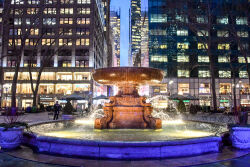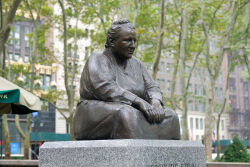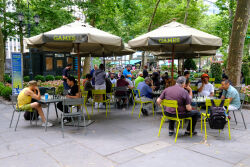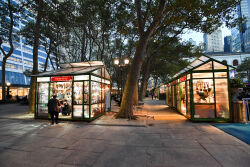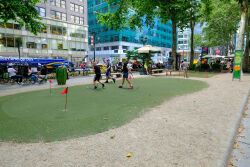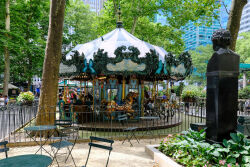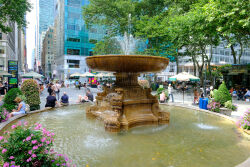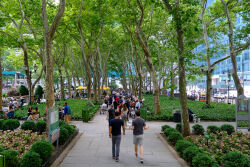Bryant Park
View all monuments in NYC Parks, as well as temporary public art installations on our NYC Public Art Map and Guide.
José Bonifacio de Andrada e Silva
| Artist: | José Otavio Correia Lima |
| Dedicated: | April 22, 1955 |
| Location: | Avenue of the Americas between West 40th and West 41st Streets |
Artwork History
In 1945 Sixth Avenue was renamed Avenue of the Americas, at the suggestion of Mayor Fiorello H. LaGuardia (1882-1947), to honor Pan-American ideals and principles. This statue, which depicts scholar, scientist, statesman and patriarch of Brazilian independence, Jose Bonifacio de Andrada e Silva (1763-1838), is one of a pantheon of six sculptures of Latin American leaders which overlook the Avenue of the Americas. Located at the Avenue’s southern end are the statues honoring Juan Pablo Duarte (1813-1876), considered the Father of the Dominican Republic, and General Jose Artigas (1764-1850), Uruguyan independence leader in Soho Square. Located on the Avenue at Central Park South are statues of the Cuban patriot, journalist, and poet, José Martí (1853-1895), Argentine General José de San Martín (1778-1850), and South American liberator Simón Bolívar (1783-1830).
Andrada was born at Villa De Santos, near Rio De Janeiro. He became a geologist, moved to Portugal, and became inspector of the state mines, as well as a professor at the University of Coimbra and secretary of the Academy at Lisbon. In 1819 Andrada returned to his native Brazil, becoming embroiled in the current political unrest. A decade earlier, when the armies of French Emperor Napoleon Bonaparte (1769–1821) threatened to invade Portugal, Dom John, the Portuguese heir to the throne, took refuge with the royal family in Brazil. After his return to Portugal at the onset of the Revolution of 1821, his son Dom Pedro remained in Brazil and led the country’s fight for independence.
Andrada and his brother Carlos Antonio held the principal posts in Dom Pedro’s coalition, and were charged with shaping policy and organizing a constitutional assembly to establish a new regime independent of the monarchy. Dom Pedro proclaimed Brazil’s independence in September 1822, and was crowned Emperor in December. Yet finding the Andrada brothers too devoted to “democratic principles” and broader freedoms, Dom Pedro dissolved the assembly in 1823, banishing Andrada to France.
Though Dom Pedro remained in power, he softened his stance, and in 1824 established a constitution based on Andrada’s principles. After many political struggles with his divided constituency, a wearied Dom Pedro abdicated his position to his five-year-old son in 1831. Andrada, who had lived in exile near Bordeaux, was permitted to return to Brazil in 1829, and was tutor to Pedro II. Credited with laying the foundation for Brazilian independence, he died in retirement at Nictheroy, across the bay from Rio.
The statue of Andrada is by Brazilian sculptor Jose Otavio Correia Lima (1878-1974), who was selected through a competition sponsored by the Brazilian government, which also contributed $60,000 for the surrounding plaza and black granite base. The nine-foot tall bronze statue was originally located at the northwest corner of Bryant Park. The dedication ceremony, presided over by Parks Commissioner Robert Moses on April 22, 1955, included an invocation by Cardinal Francis Spellman, as well as addresses by Manhattan Borough President Hulan E. Jack, Edward J. Spears, Deputy Assistant Secretary of State of Inter-American Affairs, Brazilian Ambassador to the United States, Joao Calos Muniz, and Mayor Robert F. Wagner.
In the early 1990s, the Andrada monument was moved to its current location along Avenue of the Americas, between 40th and 41st Streets, and conserved as part of the general renovation of Bryant Park completed in 1992. The original base was modified to accommodate its placement within the park’s perimeter wall. The restored statue is a fitting tribute to the continued cooperative relations between Brazil and the United States.
Artwork Details
| Description: | Standing figure (heroic scale) with integral plinth on pedestal on base decorated with applied medallion |
| Architect: | Clark and Rapuano |
| Materials: | Figure, plinth, and medallion--bronze; Pedestal, original base, and replacement base--Barre granite (polished) |
| Dimensions: | Figure H: 10'3" (includes plinth?); Figure weight: 4,000 pounds (approximate) |
| Foundry: | Fundição Cavina Ltda., Rio de Janeiro; Carbonic Engineering Co., 551 5th Avenue, New York, NY |
| Donor: | United States of Brazil |
| Cast: | 1954 |
Inscription
1) Pedestal, front: ANDRADA /2) Medallion: ESTADOS UNIDOS DO BRASIL / 15 NOVEMBRO DE 1889 /
3) Original base, proper right section: JOSE BONIFACIO DE ANDRADA E SILVA / 1763 ---1838 / PATRIARCH OF THE INDEPENDENCE / OF BRAZIL / STATESMAN --- SCIENTIST --- AUTHOR /
4) Original base, center section: ANDRADA /
5) Original base, proper left section: THIS STATUE IS THE GIFT OF THE / UNITED STATES OF BRAZIL / TO THE / UNITED STATES OF AMERICA / 1954 /
6} Front of replacement base, proper right: JOSE BONIFACIO DE ANDRADA E SILVA / 1763 [space] 1838 / PATRIARCH OF THE INDEPENDENCE / OF BRAZIL / STATESMAN --- SCIENTIST --- AUTHOR /
7) Front of replacement base, proper left: THIS STATUE IS THE GIFT OF THE / UNITED STATES OF BRAZIL / TO THE / UNITED STATES OF AMERICA / 1953 /
8) Integral plinth, proper left: RIO DE JANEIRO / C LIMA ESCULTOR --- 1954 /
9) Integral plinth, rear: FUNDIÇÃO CAVINA. LTDA / RIO DE JANEIRO --- BRASIL --- 1954/
Please note, the NAME field includes a primary designation as well as alternate namingsoften in common or popular usage. The DEDICATED field refers to the most recent dedication, most often, butnot necessarily the original dedication date. If the monument did not have a formal dedication, the yearlisted reflects the date of installation.
For more information, please contact Art & Antiquities at (212) 360-8163.
Check out your park's Vital Signs
Clean & Safe
Green & Resilient
Empowered & Engaged Users
Share your feedback or learn more about how this park is part of a
Vital Park System





